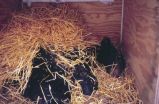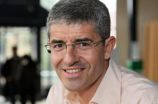(Press-News.org) The portion of the brain responsible for visual reading doesn't require vision at all, according to a new study published online on February 17 in Current Biology, a Cell Press publication. Brain imaging studies of blind people as they read words in Braille show activity in precisely the same part of the brain that lights up when sighted readers read. The findings challenge the textbook notion that the brain is divided up into regions that are specialized for processing information coming in via one sense or another, the researchers say.
"The brain is not a sensory machine, although it often looks like one; it is a task machine," said Amir Amedi of The Hebrew University of Jerusalem. "A brain area can fulfill a unique function, in this case reading, regardless of what form the sensory input takes."
Unlike other tasks that the brain performs, reading is a recent invention, about 5400 years old. Braille has been in use for less than 200 years. "That's not enough time for evolution to have shaped a brain module dedicated to reading," Amedi explained.
Nevertheless, study coauthor Laurent Cohen showed previously in sighted readers that a very specific part of the brain, known as the visual word form area or VWFA for short, has been co-opted for this purpose. But no one knew what might happen in the brains of blind people who learn to read even though they've had no visual experience at all.
In the new study, Amedi's team used functional magnetic resonance imaging to measure neural activity in eight people who had been blind since birth while they read Braille words or nonsense Braille. If the brain were organized around processing sensory information, one might expect that Braille reading would depend on regions dedicated to processing tactile information, Amedi explained. If instead the brain is task oriented, you'd expect to find the peak of activity across the entire brain in the VWFA, right where it occurs in sighted readers, and that is exactly what the researchers found.
Further comparison of brain activity in blind and sighted readers showed that the patterns in the VWFA were indistinguishable between the two groups.
"The main functional properties of the VWFA as identified in the sighted are present as well in the blind, are thus independent of the sensory modality of reading, and even more surprisingly do not require any visual experience," the researchers wrote. "To the best of our judgment, this provides the strongest support so far for the metamodal theory [of brain function]," which suggests that brain regions are defined by the tasks they perform. "Hence, the VWFA should also be referred to as the tactile word form area, or more generally as the (metamodal) word form area."
The researchers suggest that the VWFA is a multisensory integration area that binds simple features into more elaborate shape descriptions, making it ideal for the relatively new task of reading.
"Its specific anatomical location and its strong connectivity to language areas enable it to bridge high-level perceptual word representation and language-related components of reading," they wrote. "It is therefore the most suitable region to be taken over during reading acquisition, even when reading is acquired via touch without prior visual experience."
Amedi said the researchers plan to examine brain activity as people learn to read Braille for the first time, to find out how rapidly this takeover happens. "How does the brain change to process information in words?" he asked. "Is it instantaneous?"
### END
The brain as a 'task machine'
2011-02-18
ELSE PRESS RELEASES FROM THIS DATE:
Eggs' quality control mechanism explained
2011-02-18
To protect the health of future generations, body keeps a careful watch on its precious and limited supply of eggs. That's done through a key quality control process in oocytes (the immature eggs), which ensures elimination of damaged cells before they reach maturity. In a new report in the February 18th Cell, a Cell Press publication, researchers have made progress in unraveling how a factor called p63 initiates the deathblow.
In fact, p63 is a close relative of the infamous tumor suppressor p53, and both proteins recognize DNA damage. Because of this heritage it ...
Male fertility is in the bones
2011-02-18
Researchers have found an altogether unexpected connection between a hormone produced in bone and male fertility. The study in the February 18th issue of Cell, a Cell Press publication, shows that the skeletal hormone known as osteocalcin boosts testosterone production to support the survival of the germ cells that go on to become mature sperm.
The findings in mice provide the first evidence that the skeleton controls reproduction through the production of hormones, according to Gerard Karsenty of Columbia University and his colleagues.
Bone was once thought of as a ...
Bears uncouple temperature and metabolism for hibernation, new study shows
2011-02-18
This release is available in French, Spanish, Arabic, Japanese and Chinese on EurekAlert! Chinese.
Several American black bears, captured by the Alaska Department of Fish and Game after wandering a bit too close to human communities, have given researchers the opportunity to study hibernation in these large mammals like never before. Surprisingly, the new findings show that although black bears only reduce their body temperatures slightly during hibernation, their metabolic activity drops dramatically, slowing to about 25 percent of their normal, active rates.
This ...
Scientists build world's first anti-laser
2011-02-18
New Haven, Conn.—More than 50 years after the invention of the laser, scientists at Yale University have built the world's first anti-laser, in which incoming beams of light interfere with one another in such a way as to perfectly cancel each other out. The discovery could pave the way for a number of novel technologies with applications in everything from optical computing to radiology.
Conventional lasers, which were first invented in 1960, use a so-called "gain medium," usually a semiconductor like gallium arsenide, to produce a focused beam of coherent light—light ...
The real avatar
2011-02-18
That feeling of being in, and owning, your own body is a fundamental human experience. But where does it originate and how does it come to be? Now, Professor Olaf Blanke, a neurologist with the Brain Mind Institute at EPFL and the Department of Neurology at the University of Geneva in Switzerland, announces an important step in decoding the phenomenon. By combining techniques from cognitive science with those of Virtual Reality (VR) and brain imaging, he and his team are narrowing in on the first experimental, data-driven approach to understanding self-consciousness.
In ...
Taking brain-computer interfaces to the next phase
2011-02-18
You may have heard of virtual keyboards controlled by thought, brain-powered wheelchairs, and neuro-prosthetic limbs. But powering these machines can be downright tiring, a fact that prevents the technology from being of much use to people with disabilities, among others. Professor José del R. Millán and his team at the Ecole Polytechnique Fédérale de Lausanne (EPFL) in Switzerland have a solution: engineer the system so that it learns about its user, allows for periods of rest, and even multitasking.
In a typical brain-computer interface (BCI) set-up, users can send ...
Skeleton regulates male fertility
2011-02-18
NEW YORK (February 17, 2011) – Researchers at Columbia University Medical Center have discovered that the skeleton acts as a regulator of fertility in male mice through a hormone released by bone, known as osteocalcin.
The research, led by Gerard Karsenty, M.D., Ph.D., chair of the Department of Genetics and Development at Columbia University Medical Center, is slated to appear online on February 17 in Cell, ahead of the journal's print edition, scheduled for March 4.
Until now, interactions between bone and the reproductive system have focused only on the influence ...
Put major government policy options through a science test first, biodiversity experts urge
2011-02-18
Scientific advice on the consequences of specific policy options confronting government decision makers is key to managing global biodiversity change.
That's the view of leading scientists anxiously anticipating the first meeting of a new Intergovernmental Panel on Climate Change (IPCC)-like mechanism for biodiversity at which its workings and work program will be defined.
Writing in the journal Science, the scientists say the new mechanism, called the Intergovernmental Platform on Biodiversity and Ecosystem Services (IPBES), should adopt a modified working approach ...
Subtle shifts, not major sweeps, drove human evolution
2011-02-18
The most popular model used by geneticists for the last 35 years to detect the footprints of human evolution may overlook more common subtle changes, a new international study finds.
Classic selective sweeps, when a beneficial genetic mutation quickly spreads through the human population, are thought to have been the primary driver of human evolution. But a new computational analysis, published in the February 18, 2011 issue of Science, reveals that such events may have been rare, with little influence on the history of our species.
By examining the sequences of nearly ...
Dr. Todd Kuiken, pioneer of bionic arm control at RIC, to present latest advances at AAAS meeting
2011-02-18
VIDEO:
Glen Lehman discusses his research.
Click here for more information.
WASHINGTON (February 17) –Todd Kuiken, M.D., Ph.D., Director of the Center for Bionic Medicine and Director of Amputee Services at The Rehabilitation Institute of Chicago (RIC), designated the "#1 Rehabilitation Hospital in America" by U.S. News & World Report since 1991, will present the latest in Targeted Muscle Reinnervation (TMR), a bionic limb technology, during the opening press briefing and ...


